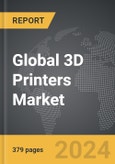The global market for 3D Printers is estimated at US$14.7 Billion in 2023 and is projected to reach US$41.9 Billion by 2030, growing at a CAGR of 16.1% from 2023 to 2030. This comprehensive report provides an in-depth analysis of market trends, drivers, and forecasts, helping you make informed business decisions.
Several key factors drive the growth of 3D printing technology. Improved printer precision, driven by advancements in software and hardware, has significantly enhanced the quality of printed objects, making the technology viable for applications requiring high accuracy. Faster printing speeds reduce the time required to produce prototypes and finished products, supporting quicker design iterations and shorter production cycles. Integration with computer-aided design (CAD) software and artificial intelligence (AI) has streamlined the design-to-production process, enhancing capability and efficiency. The combination of 3D printing with the Internet of Things (IoT) enables real-time monitoring, predictive maintenance, and optimization of manufacturing processes. The growing consumer demand for personalized and custom products drives the adoption of 3D printers, allowing for the creation of bespoke items tailored to individual preferences. Additionally, increased use in educational institutions, research and development, sustainable manufacturing practices, evolving standards and certifications, industry-specific solutions, collaborative ecosystems, and the rise of DIY culture further propel the adoption and innovation in 3D printing technology, making it a dynamic and evolving field.
Several key factors drive the growth of 3D printing technology. Improved printer precision, driven by advancements in software and hardware, has significantly enhanced the quality of printed objects, making the technology viable for applications requiring high accuracy. Faster printing speeds reduce the time required to produce prototypes and finished products, supporting quicker design iterations and shorter production cycles. Integration with computer-aided design (CAD) software and artificial intelligence (AI) has streamlined the design-to-production process, enhancing capability and efficiency. The combination of 3D printing with the Internet of Things (IoT) enables real-time monitoring, predictive maintenance, and optimization of manufacturing processes. The growing consumer demand for personalized and custom products drives the adoption of 3D printers, allowing for the creation of bespoke items tailored to individual preferences. Additionally, increased use in educational institutions, research and development, sustainable manufacturing practices, evolving standards and certifications, industry-specific solutions, collaborative ecosystems, and the rise of DIY culture further propel the adoption and innovation in 3D printing technology, making it a dynamic and evolving field.
Key Insights:
- Market Growth: Understand the significant growth trajectory of the 3D Printers segment, which is expected to reach US$13.4 Billion by 2030 with a CAGR of a 13.5%. The 3D Printing Services segment is also set to grow at 17.0% CAGR over the analysis period.
- Regional Analysis: Gain insights into the U.S. market, estimated at $3.9 Billion in 2023, and China, forecasted to grow at an impressive 23.6% CAGR to reach $11.4 Billion by 2030. Discover growth trends in other key regions, including Japan, Canada, Germany, and the Asia-Pacific.
Why You Should Buy This Report:
- Detailed Market Analysis: Access a thorough analysis of the Global 3D Printers Market, covering all major geographic regions and market segments.
- Competitive Insights: Get an overview of the competitive landscape, including the market presence of major players across different geographies.
- Future Trends and Drivers: Understand the key trends and drivers shaping the future of the Global 3D Printers Market.
- Actionable Insights: Benefit from actionable insights that can help you identify new revenue opportunities and make strategic business decisions.
Key Questions Answered:
- How is the Global 3D Printers Market expected to evolve by 2030?
- What are the main drivers and restraints affecting the market?
- Which market segments will grow the most over the forecast period?
- How will market shares for different regions and segments change by 2030?
- Who are the leading players in the market, and what are their prospects?
Report Features:
- Comprehensive Market Data: Independent analysis of annual sales and market forecasts in US$ Million from 2023 to 2030.
- In-Depth Regional Analysis: Detailed insights into key markets, including the U.S., China, Japan, Canada, Europe, Asia-Pacific, Latin America, Middle East, and Africa.
- Company Profiles: Coverage of major players such as 3D Systems, Inc., Arcam AB, envisionTEC GmbH, and more.
- Complimentary Updates: Receive free report updates for one year to keep you informed of the latest market developments.
Select Competitors (Total 254 Featured):
- 3D Systems, Inc.
- Arcam AB
- envisionTEC GmbH
- EOS GmbH
- MakerBot® Industries, LLC
- Solidscape, Inc.
- Stratasys Ltd.
- The ExOne Company
Table of Contents
I. METHODOLOGYII. EXECUTIVE SUMMARY2. FOCUS ON SELECT PLAYERSIII. MARKET ANALYSISCANADAITALYSPAINRUSSIAREST OF EUROPESOUTH KOREAREST OF ASIA-PACIFICARGENTINABRAZILMEXICOREST OF LATIN AMERICAIRANISRAELSAUDI ARABIAUNITED ARAB EMIRATESREST OF MIDDLE EASTIV. COMPETITION
1. MARKET OVERVIEW
3. MARKET TRENDS & DRIVERS
4. GLOBAL MARKET PERSPECTIVE
UNITED STATES
JAPAN
CHINA
EUROPE
FRANCE
GERMANY
UNITED KINGDOM
ASIA-PACIFIC
AUSTRALIA
INDIA
LATIN AMERICA
MIDDLE EAST
AFRICA
Companies Mentioned
- 3D Systems, Inc.
- Arcam AB
- envisionTEC GmbH
- EOS GmbH
- MakerBot® Industries, LLC
- Solidscape, Inc.
- Stratasys Ltd.
- The ExOne Company
Table Information
| Report Attribute | Details |
|---|---|
| No. of Pages | 379 |
| Published | December 2024 |
| Forecast Period | 2023 - 2030 |
| Estimated Market Value ( USD | $ 14.7 Billion |
| Forecasted Market Value ( USD | $ 41.9 Billion |
| Compound Annual Growth Rate | 16.1% |
| Regions Covered | Global |
| No. of Companies Mentioned | 8 |









